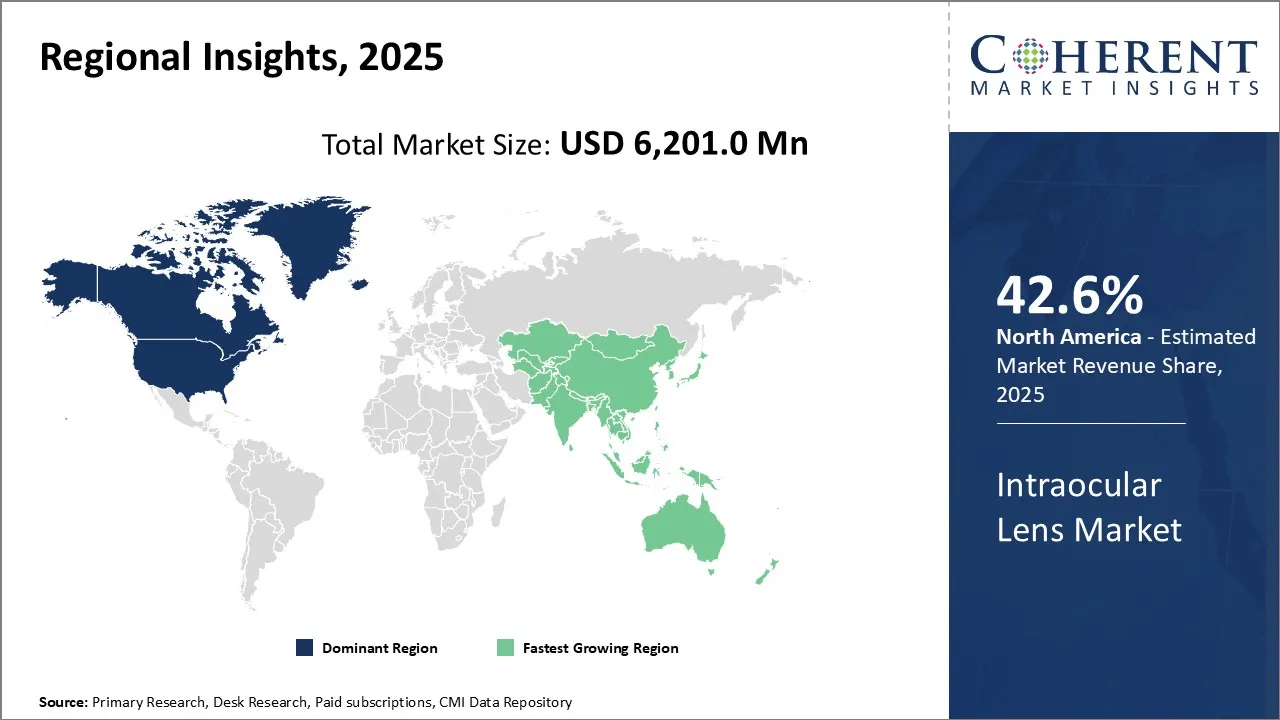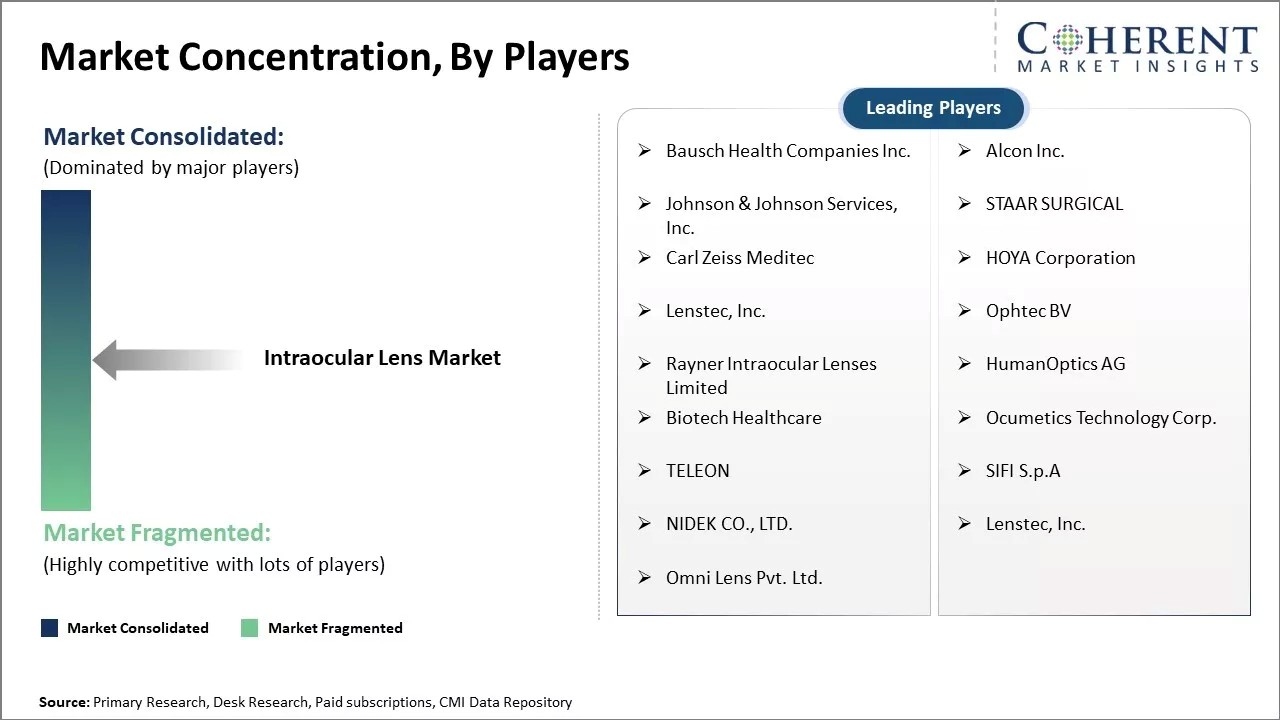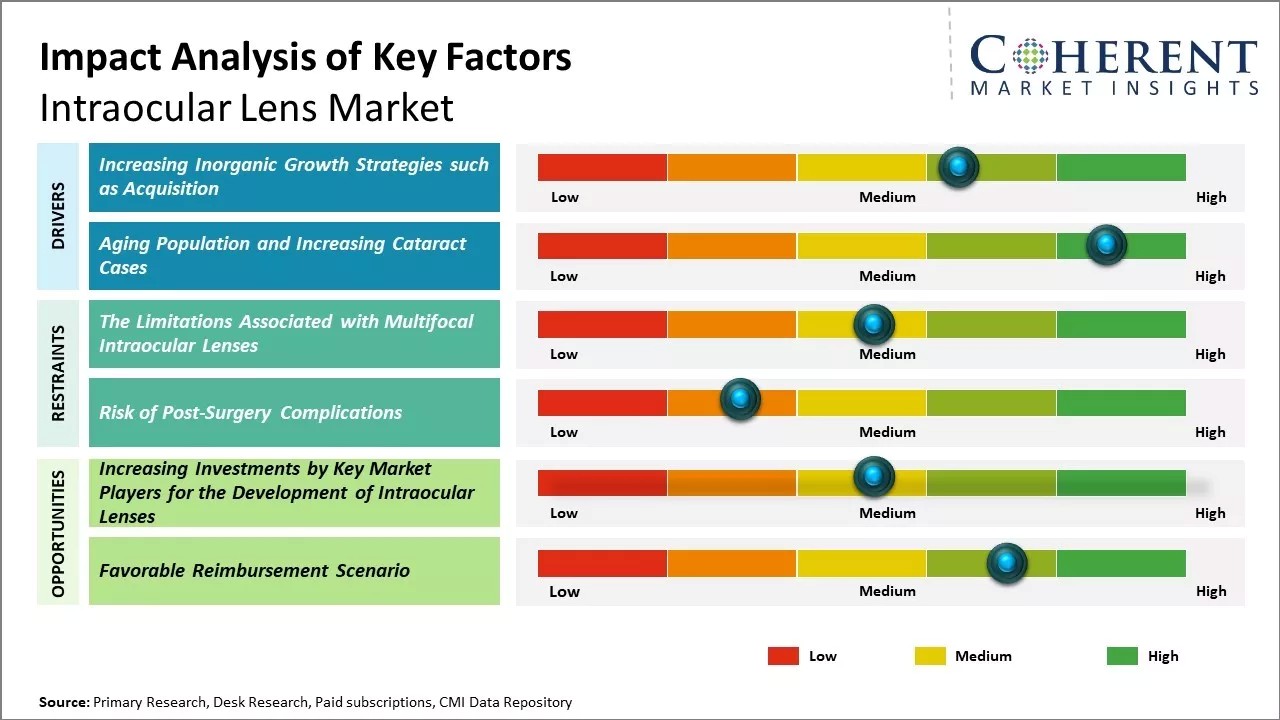The global intraocular lens market is estimated to be valued at USD 6,201.0 Mn in 2025 and is expected to exhibit a compound annual growth rate (CAGR) of 7.7% during the forecast period, reaching USD 10,429.2 Mn by 2032.
The global intraocular lens market is expected to grow steadily during the forecast period. Increasing prevalence of cataracts and other eye diseases globally is a prominent factor driving intraocular lens industry growth.
According to the World Health Organization (WHO), cataract is one of the leading causes of blindness worldwide, accounting for around 94 Mn cases of vision impairment or blindness. Growing geriatric population, which is more prone to developing cataracts, along with rising awareness about early cataract treatment, is expected to propel demand for intraocular lenses.
Moreover, technological advancements in intraocular lenses, including the introduction of premium and multifocal variants, are expected to drive market growth. These innovations enhance visual outcomes as well as patient satisfaction, further fueling market expansion during the forecast period.
There is an increase in new product launches and approvals globally as the demand for intraocular lens implants grows. For instance, in October 2025, Rayner received U.S. FDA approval for its RayOne EMV Toric intraocular lens.
The new approval gives U.S. surgeons a new option for patients with astigmatism, expanding the toric IOL segment. Such new approvals will likely support market expansion. However, high cost of advanced intraocular lenses and absence of reimbursement policies in developing nations may hamper market growth to some extent during the forthcoming period.
|
Current Event |
Description and its Impact |
|
Global Aging Demographics and Healthcare Expansion |
|
|
Technological Advancement and Innovation Surge |
|
Uncover macros and micros vetted on 75+ parameters: Get instant access to report
Monofocal intraocular lens is expected to remain a highly sought-after product type during the forecast period. This is due to its affordability and effectiveness in correcting vision impairments for cataract patients. The target segment will likely account for 36.4% of the market share in 2025.
As cataracts pose a significant healthcare burden, there is an emphasis on making IOL procedures more accessible through cost-effective options. Monofocal IOLs offer excellent vision outcomes at a lower price point compared to advanced lens types, enabling more patients globally to benefit from cataract surgery.
The widespread use of monofocal intraocular lenses, especially in developing nations, buttresses their market dominance. Furthermore, favorable reimbursement programs covering basic monofocal IOLs in certain countries aid their demand. While premium lenses are gaining ground, cost considerations continue to favor monofocal IOLs for the broader population.
Companies in the industry are regularly launching new products to take advantage of new opportunities. For example, BVI recently launched its new SERENITY and SERENITY Toric premium monofocal intraocular lenses (IOLs).
These lenses are the second generation of BVI’s ISOPURE family and use a special ISOFOCAL optic technology. They are made to give clear distance vision and better intermediate vision for daily tasks like reading or using a computer. The SERENITY Toric version also helps correct astigmatism and stays steady in the eye for consistent vision results.
As per Coherent Market Insights’ latest intraocular lens market analysis, polymethylmethacrylate (PMMA) segment is estimated to hold 28.9% of the market share in 2025. This is attributable to widespread adoption of polymethylmethacrylate lenses, especially in developing markets.
PMMA, the first synthetic material approved for intraocular lenses, has a strong safety record, long shelf life, and excellent optical stability. Its durable structure provides reliable vision correction.
Simple packaging, easy handling, and good preservation make PMMA lenses cost-effective, supporting their wide use in public healthcare systems in Asia and Latin America. Even with the rise of newer materials, PMMA’s low cost and trusted performance keep it important in the market.
Hospitals segment is expected to hold a prominent market share of 46.4% in 2025. This is because they perform the highest volume of cataract surgeries, leading to higher demand for intraocular lenses (IOLs). Specialized ophthalmology units within large hospitals, along with credentialed team of surgeons, are well placed to efficiently conduct cataract procedures on a mass scale.
Hospitals additionally gain from the ubiquitous trust they command over local clinics and ambulatory settings for precision surgery as well as management of complications. This brings a greater number of patients under their umbrella for IOL implantation and follow-ups.
Further, bulk procurement through hospitals earns attractive discounts from manufacturers. Insured healthcare infrastructure also makes hospitals the default choice. Therefore, their technical expertise and scope of comprehensive care cements the lead of hospitals as end users of intraocular lenses.

To learn more about this report, Download Free Sample
North America is expected to dominate the global intraocular lens market, holding a share of 42.6% in 2025. This can be attributed to high prevalence of cataract cases, increased adoption of premium intraocular lenses, and strong presence of leading manufacturers such as Alcon, Johnson & Johnson Vision, and Bausch + Lomb.
North America is home to some of the leading original equipment manufacturers (OEMs). These players have established the region as center for innovation in intraocular lens technology. They spend heavily on R&D, which has resulted in new proprietary lens designs, biomaterials, and delivery systems.
For instance, in April 2025, Alcon introduced the Clareon PanOptix Pro intraocular lens for cataract patients in the United States. The lens uses Alcon’s proprietary ENLIGHTEN® NXT optical technology, which is claimed to deliver very high light utilization while minimizing light scatter.
Favorable reimbursement policies and growing awareness about advanced vision correction options are boosting sales of intraocular lenses in the region. Similarly, technological innovations such as extended depth-of-focus (EDOF) and toric IOLs strengthen the region’s market position.
Asia Pacific is emerging as the fastest growing market for intraocular lenses. Countries like India, China, Japan, and South Korea have growing elderly populations with greater needs for cataract treatment. This is creating lucrative growth opportunities for intraocular lens manufacturers.
Favorable healthcare reforms and insurance coverage in Asia Pacific nations have made corrective eye procedures more accessible and affordable for locals. At the same time, manufacturing costs are lower in Asia Pacific, enabling both global and local suppliers to price lenses very competitively.
While multinational corporations once dominated the export market from the region, domestic Asian firms are rapidly advancing their technology and quality standards. A few homegrown Asian brands today give as good performance as some leading imported lenses. With rising incomes and awareness about eye care, Asia Pacific's demand for intraocular lenses will likely continue outpacing other regions.
The United States is expected to lead the global intraocular lens industry during the forecast period. This is attributable to rising prevalence of cataracts and age-related eye disorders among the country’s large elderly population.
Growing preference for premium intraocular lenses (IOLs), including multifocal and toric variants, is driving market growth. These advanced lenses offer improved visual outcomes and minimize patients’ reliance on glasses after cataract surgery.
Moreover, strong healthcare infrastructure, favorable reimbursement policies, and continuous advancements in ophthalmic technology are fueling market growth in the U.S. Surgeons and hospitals are increasingly using advanced femtosecond laser-assisted cataract surgery and intraoperative aberrometry. This is creating a strong demand for intraocular lenses in the nation.
China is anticipated to emerge as the fastest-growing intraocular lens market during the assessment period. This is mostly due to the rising geriatric population, increasing incidence of eye diseases, and rapid expansion of healthcare services across urban and rural areas.
The government’s focus on improving access to eye care through national blindness prevention programs and public health initiatives is also playing a vital role in driving demand for IOLs. In addition, growing awareness about advanced cataract treatments and increasing affordability of surgical procedures are boosting market growth in China.
Technological innovations, such as foldable and aspheric lenses, are gaining popularity among patients seeking better vision correction. The expanding network of specialized ophthalmic clinics and partnerships between hospitals and lens producers are further strengthening the country’s intraocular lens market outlook.

To learn more about this report, Download Free Sample
| Report Coverage | Details | ||
|---|---|---|---|
| Base Year: | 2024 | Market Size in 2025: | USD 6,201.0 Mn |
| Historical Data for: | 2020 To 2024 | Forecast Period: | 2025 To 2032 |
| Forecast Period 2025 to 2032 CAGR: | 7.7% | 2032 Value Projection: | USD 10,429.2 Mn |
| Geographies covered: |
|
||
| Segments covered: |
|
||
| Companies covered: |
Bausch Health Companies Inc., Alcon Inc., Johnson & Johnson Services, Inc., STAAR SURGICAL, Carl Zeiss Meditec, HOYA Corporation, Lenstec, Inc., Ophtec BV, Rayner Intraocular Lenses Limited, HumanOptics AG, Biotech Healthcare, Ocumetics Technology Corp., TELEON, SIFI S.p.A, NIDEK CO., LTD., Lenstec, Inc., and Omni Lens Pvt. Ltd. |
||
| Growth Drivers: |
|
||
| Restraints & Challenges: |
|
||
Uncover macros and micros vetted on 75+ parameters: Get instant access to report

To learn more about this report, Download Free Sample
The global population is ageing at an unprecedented rate. The percentage of people aged 65 years and above is growing steadily, and this ageing population is more susceptible to developing cataract and other age-related eye diseases. As per the estimates by the WHO, the number of cataract operations will need to rise significantly over the next 10 years to keep up with the demand from an ageing population alone.
Many developed countries have already seen their average age rising over the past few decades, and this trend is now spreading to developing regions as well. This is expected to stimulate growth of the intraocular lens market during the forecast period.
Leading manufacturers of intraocular lenses are increasingly adopting strategies like acquisitions and partnerships to stay ahead of the competition. For instance, in January 2023, Bausch Health Companies Inc., a global eye health company, announced that it had acquired AcuFocus, Inc. (“AcuFocus”), a privately held ophthalmic medical device company, to address the diverse unmet needs in eye care. AcuFocus develops small aperture intraocular technology. Its portfolio includes the IC-8 Apthera intraocular lens (IOL).
Key players are investing in the development of novel intraocular lens technologies, presenting lucrative opportunities for the global IOL market. For example, Adaptilens, a developer of accommodating (or biomimetic) intraocular lenses, raised US$ 1.6 million in a seed round led by Pillar VC, with participation from Accanto Partners.
Share
Share
About Author
Manisha Vibhute is a consultant with over 5 years of experience in market research and consulting. With a strong understanding of market dynamics, Manisha assists clients in developing effective market access strategies. She helps medical device companies navigate pricing, reimbursement, and regulatory pathways to ensure successful product launches.
Missing comfort of reading report in your local language? Find your preferred language :
Transform your Strategy with Exclusive Trending Reports :
Frequently Asked Questions
Joining thousands of companies around the world committed to making the Excellent Business Solutions.
View All Our Clients